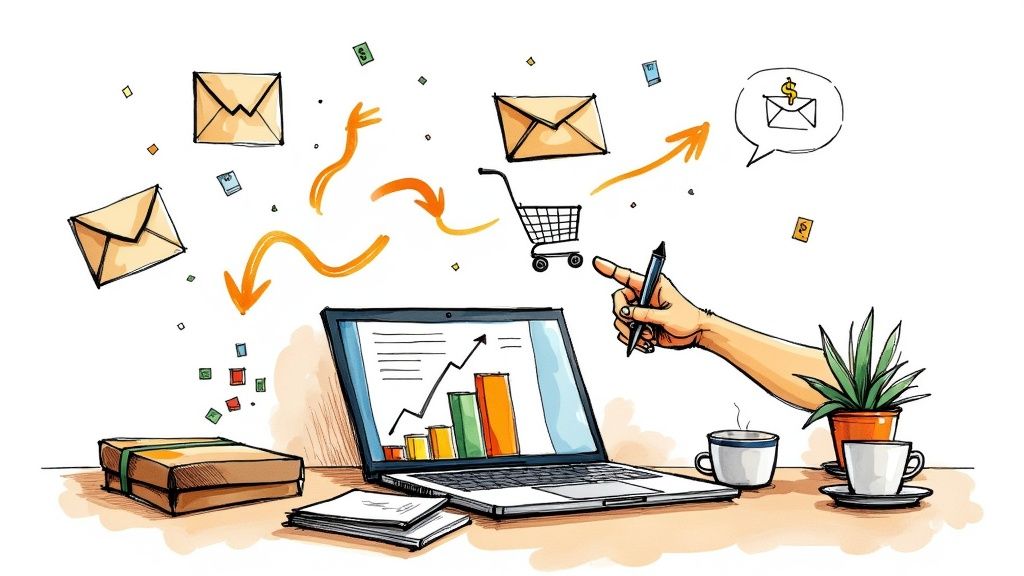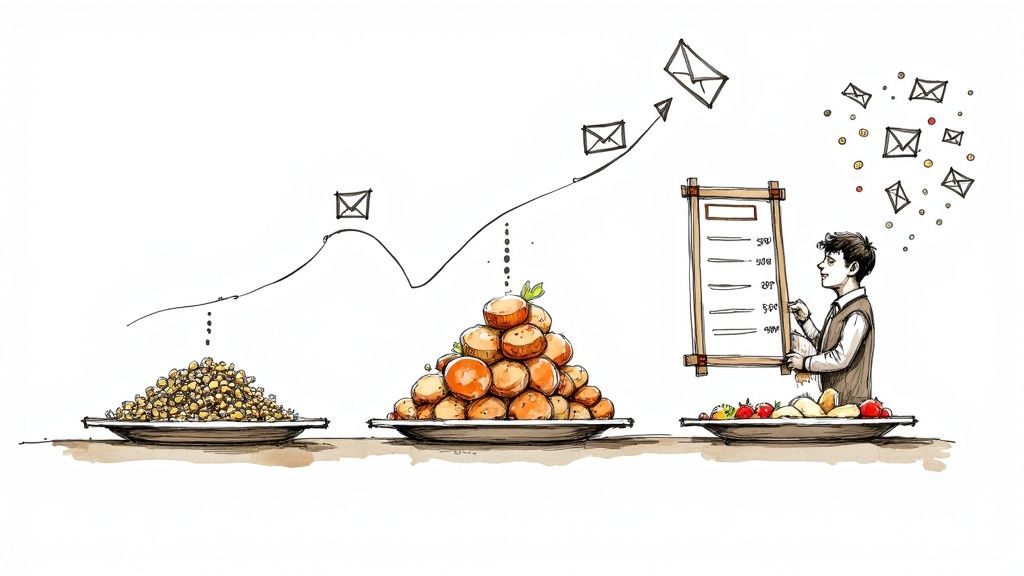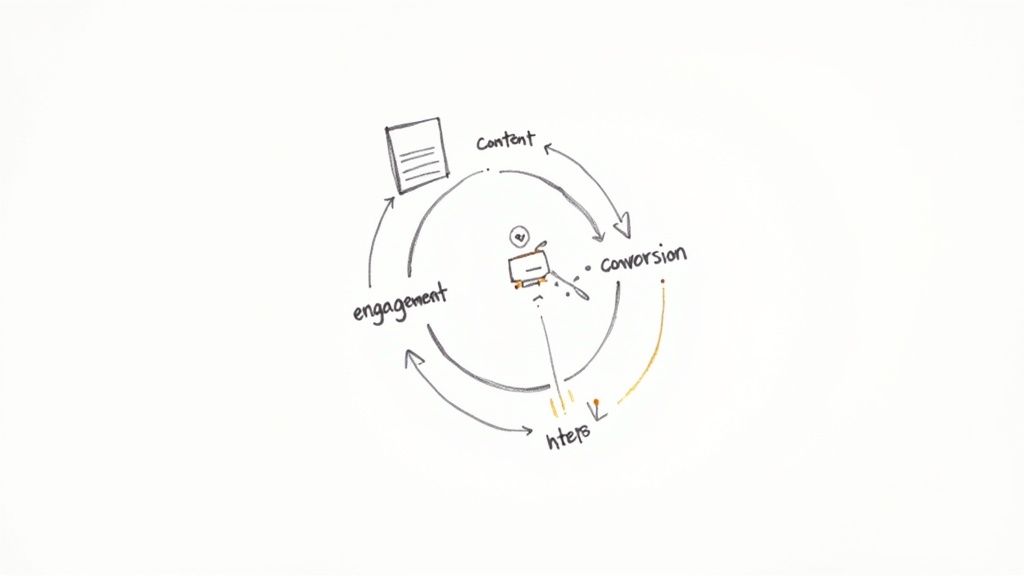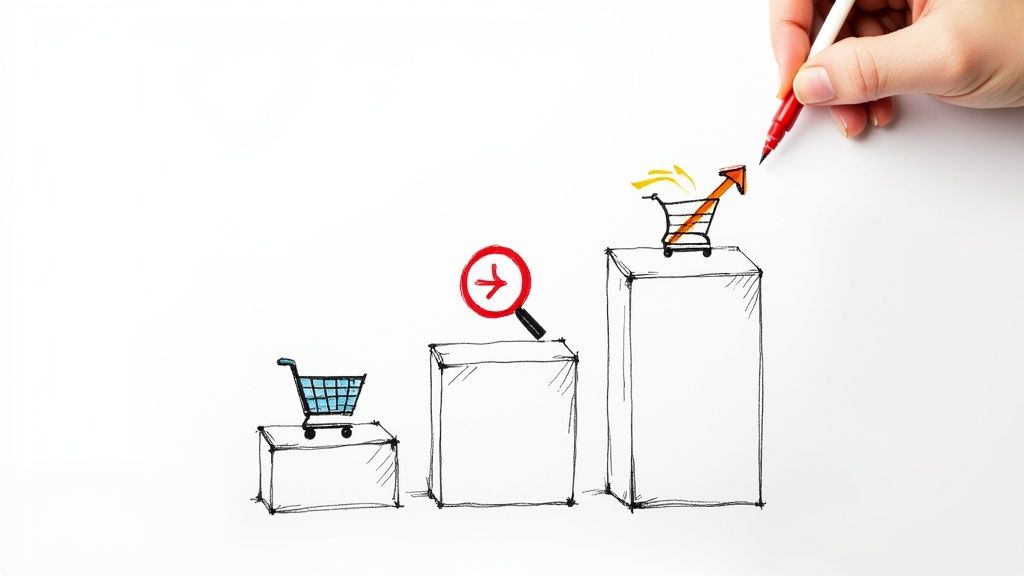Content Marketing for E-Commerce: Boost Your Growth Today
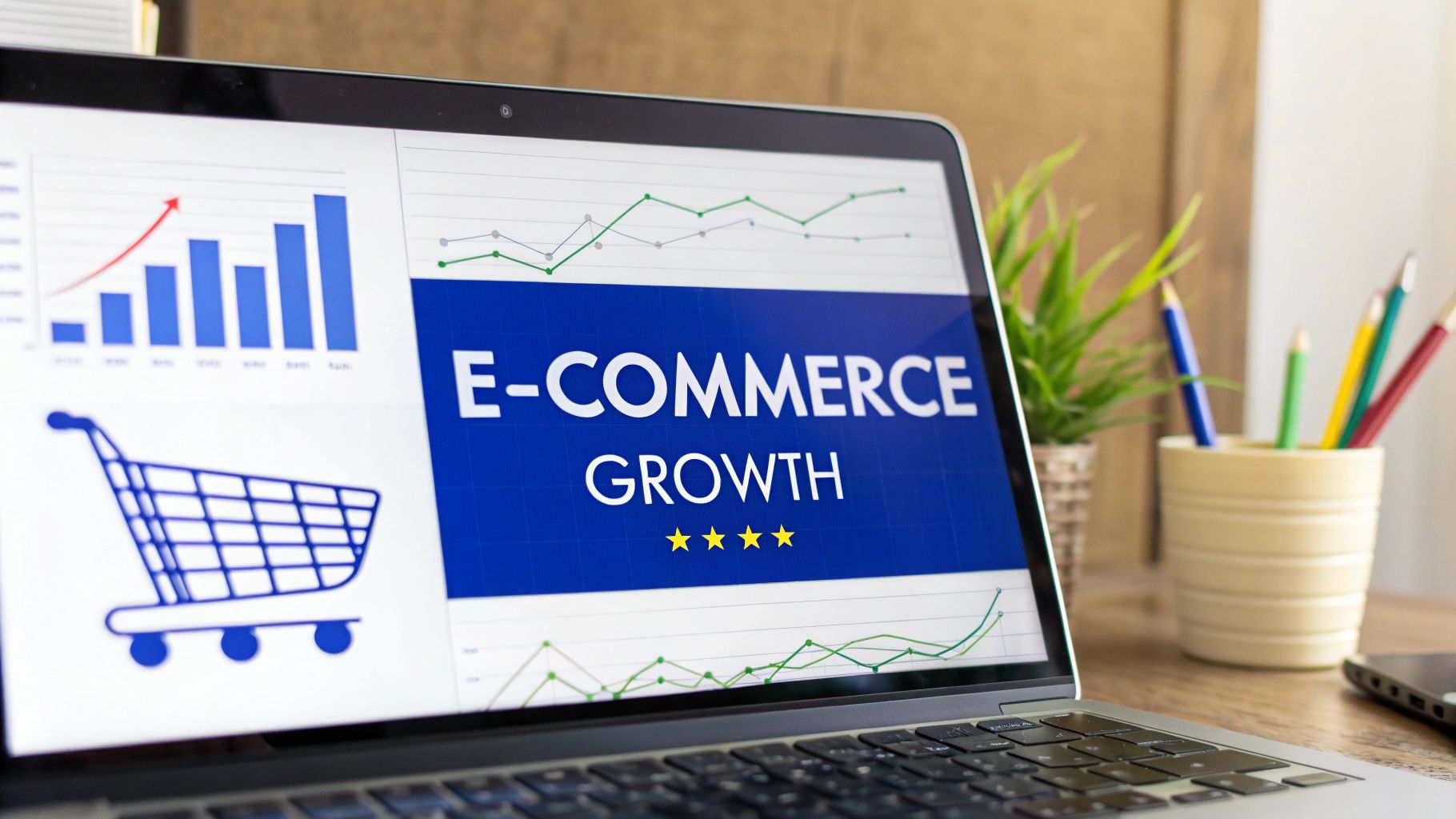
13 mins
5/22/2025
Joe Ervin
- content marketing for e-commerce
- e-commerce strategy
- digital marketing
- conversion optimization
- online retail
Basics of E-Commerce Content Marketing
Content marketing for e-commerce isn't just putting product details online. It's about making a content world to help customers at each step of buying. Think of it as a tour of your online shop, where fun content is a friendly guide. This is different from old-fashioned ads, which can feel cold and pushy.
Knowing the E-Commerce Customer Journey
To do well in e-commerce content marketing, you need to know how customers act. Online shoppers have all the control. They check out products, compare prices, and often leave carts without buying. Your content should solve their worries, answer their questions, and build trust. This way, they become loyal buyers.
For example, someone looking for a coffee maker might start by learning about brewing ways. Blog posts comparing French press and pour-over techniques can help. Later, as they decide, product reviews and comparisons matter more. Videos showing your coffee maker's features can be very useful then.
Linking Content to Buying Intent
A good e-commerce content plan ties different content to buying stages.
Awareness Stage: Blog posts, articles, and infographics teach potential buyers about their needs and show your brand as a solution.
Consideration Stage: Product comparisons, reviews, and buying guides help buyers pick options and focus their choices.
Decision Stage: Product demos, customer testimonials, and special offers push purchases.
Post-Purchase Stage: How-to videos, FAQs, and emails offer support and build loyalty.
Content marketing in e-commerce is growing fast. It's set to reach $107 billion globally by 2025, with 54% of businesses planning to up their content budget in 2024. See more stats here. This shows how important content is for engaging customers and boosting sales.
Building Trust and Being Real
Trust is key in online business. User reviews and testimonials provide real social proof that connects with buyers. Behind-the-scenes content shows your brand's values and personality, linking you to your audience. This openness builds trust, encouraging sales and repeat business. Building genuine bonds with your audience is a smart move for your e-commerce shop's future.
Making an E-Commerce Content Strategy That Works
Running a successful online store takes more than random social media posts. It needs a solid e-commerce content strategy to attract customers and boost sales. Let's see how top online stores use content to guide customers to buy. It starts with knowing the customer journey and making content for each step, from discovering your brand to becoming a fan.
Setting Clear Content Goals and KPIs
A solid e-commerce content plan starts with clear goals. These should connect to your business aims, not just numbers like visits or likes. Focus on numbers that affect your profits. What are some example goals?
Increase Brand Awareness: If you want to reach new people, track website traffic, social media followers, and brand mentions.
Drive Sales: To boost sales, watch conversion rates, average order value, and money made from content.
Improve Customer Retention: If you want loyal customers, track repeat buys, customer lifetime value, and engagement with post-purchase content.
Setting clear goals is hard. Only 29% of marketers with a content plan find it effective. A big 42% of failing plans blame unclear goals. Read more about these stats here. This shows why setting SMART goals is important: specific, measurable, achievable, relevant, and time-bound.
Here's a table showing SMART goals and tracking success:
E-Commerce Content Marketing Goals and KPIs
Content Marketing Goal | Relevant Content Types | Key Performance Indicators (KPIs) |
|---|---|---|
Increase Brand Awareness | Blog posts, social media updates, infographics, videos | Website traffic, social media followers, reach, brand mentions |
Drive Sales | Product descriptions, product reviews, customer testimonials, promotional emails | Conversion rates, average order value, revenue from content, cart abandonment |
Improve Customer Retention | Post-purchase emails, loyalty programs, exclusive content, customer support resources | Repeat purchase rate, customer lifetime value, satisfaction scores, post-purchase engagement |
This table shows how different content types help meet marketing goals and track progress. Using this can help you set your own goals and measure your content marketing success.
Knowing Your Audience
Knowing your audience is crucial. Good e-commerce content marketing depends on understanding their needs, likes, and problems. Deep customer research is key to learning about their age, buying habits, and preferred content. This helps you make content that resonates with your market.
The infographic below shows key data from recent customer research, including customer age group distribution, preferred content formats, and monthly engagement rate growth.

The data shows many customers are aged 25-34. They like blog content. There's steady growth in engagement. This means our content strategy works. It also helps us know what content to make and how to share it. This way, we make content that connects with our audience. This leads to more sales and happy customers.
Finding Content Gaps
Look at what your competitors do. See what they do well and where they miss. This helps you find chances to make unique content. If they use many blog posts, try using videos or other tools to stand out.
Know your audience, have clear goals, and check out the competition. This helps you make a good content plan. It attracts, engages, and turns visitors into buyers. This helps grow your online store.
Good Content Types for Online Stores

In e-commerce, not all content works the same. Knowing which types connect with your audience is key to getting more sales. You need content that informs and encourages buying. Let’s look at some top content types for online stores.
Product Videos: Show Your Products in Action
Product videos let you show off your products. They offer more detail than pictures or words. For example, a clothing store can show how clothes fit. A tech company can show how a gadget works. This can lead to more sales, sometimes up to 2-3 times more. Product videos are great for selling.
Interactive Buying Guides: Help for Shoppers
Interactive buying guides help buyers make smart choices. They give advice and info. It’s like having a virtual helper all the time. A furniture store could have a guide to help pick the right sofa based on room size, style, and budget. This makes buying easier and less scary, which means more sales.
User-Generated Content: Real and Trustworthy
User-generated content (UGC) like reviews and stories from customers builds trust. People care about what others say. UGC shows real proof that a product is good. It helps build a good name for your brand and keeps customers coming back.
29% of marketers spend 10-15 hours a week making good content. Video content is very good. 59% of marketers use video because it works well. Visual content is 43% more convincing than just words. Learn more about content marketing statistics. This shows why using videos and interactive content is important.
Blog Posts: Share and Engage
Blog posts are a way to share useful info and solve problems. They show your brand knows its stuff. Good blog posts can bring in new customers from search engines. They build trust and can lead to more visits to your product pages. Blogs let you talk more about your products, boosting your authority.
Mixing Content Types: A Smart Approach
Winning e-commerce brands use different content types together. They make a smooth journey for customers. This could start with a blog post that talks about a problem. Then, a video shows a solution. Finally, reviews from users build trust and drive sales. This approach meets customer needs at every step, making your content more powerful.
Using these content types in your strategy makes online shopping more fun and convincing. This leads to more sales, happy customers, and a successful business.
Creating great content is only part of the job. You also need to make sure people see it. This means sharing your content smartly to get the most views and value.
Picking the Right Places to Share
It's important to know where your audience spends time online. You might use several ways to share your content.
Email Marketing: Send special content straight to subscribers. Use personalized emails based on their past choices.
Social Media: Connect with your audience on sites like Instagram, Facebook, and Pinterest. Change your content to fit each site.
SEO: Attract people who are searching for what you offer. Good SEO helps your content show up in search results.
Paid Ads: Use ads on social media and search engines like Google to get more views. Target specific groups to help your organic reach.
89% of B2B marketers use social media to share content. This shows how important it is to mix content marketing with your digital plan. This helps more people see and interact with your brand.
Changing Content for Different Platforms
It's important to keep your brand the same, but change your content for each platform. You can reuse a blog post in different ways:
Infographics for Instagram: Turn key facts into simple visuals.
Short Videos for TikTok: Make quick, fun videos to grab attention.
Email Newsletter Snippets: Share parts of blog posts to bring people back to your site.
Reusing content makes it last longer and reach more people.
Creating Easy Sharing Workflows
Easy sharing needs simple workflows. Here's how:
Content Reuse: Change old content into different forms for other places.
Automation Tools: Schedule social media posts and automate emails to save time.
Performance Check: Track things like clicks and sales to improve your efforts.
Balancing Free and Paid Reach
It's important to find the right mix of free and paid reach. Free reach builds trust, while paid gives more visibility. Your budget should match your goals and audience.
Timing for Best Engagement
Knowing when your audience is online is key. Post when they're most active or send emails when they're likely to open them. Base timing on their online habits.
Using Attribution Models
Measure how different content parts help sales with attribution models. Multi-touch attribution gives a full view of the customer journey. This helps refine your strategy and invest in the best channels.
Measuring How Well Sharing Works
Tracking key metrics is important. Here are some to consider:
Website Traffic: See which sources bring the most visitors.
Engagement Metrics: Track likes, comments, shares, and time spent on the page.
Conversion Rates: Measure users' actions like signing up for a newsletter or making a purchase.
Analyzing these helps make better content and sharing decisions. Keep improving based on data to ensure your content reaches the right people and helps your business grow.
SEO-Driven Content: Capturing High-Intent Buyers

Search engines are a powerful tool for e-commerce businesses, connecting you with customers actively looking for products like yours. This section explores how SEO-driven content marketing for e-commerce helps you capture these high-intent buyers. We'll cover understanding search intent, optimizing your content, and building a comprehensive content ecosystem.
Understanding Search Intent: What Are Your Customers Looking For?
Effective SEO begins with understanding search intent. This means knowing the reason behind a user's search. Are they simply seeking information, comparing various products, or are they ready to make a purchase?
For example, a search for "best winter boots for hiking" suggests a customer in the consideration phase. Conversely, a search for "buy North Face winter boots size 9" indicates a readiness to buy. Your content's effectiveness hinges on aligning with the searcher's intent.
Keyword Research: Targeting the Right Terms
Keyword research forms the foundation of SEO. It involves identifying the terms your target audience uses when searching for products or information related to your business.
Prioritize commercial keywords, which signal purchase intent. These often include terms like "buy," "discount," "sale," or specific product names. Tools like Ahrefs or SEMrush can help you uncover relevant keywords, analyze their search volume, and assess the competition.
On-Page Optimization: Making Your Content Search-Engine Friendly
On-page optimization encompasses techniques used to improve your website's ranking for specific keywords. This includes several key areas:
Optimizing Product Descriptions: Incorporate relevant keywords naturally within your product descriptions, focusing on the benefits customers will enjoy, not just the features.
Creating SEO-Friendly Category Pages: Optimize category pages with relevant keywords and clear, concise descriptions to improve their visibility.
Developing Buying Guides and Comparison Charts: Create helpful content that addresses customer pain points and empowers them to make informed purchasing decisions.
These practices not only enhance your SEO but also improve the user experience. They make it easier for customers to find the information they need, ultimately driving organic traffic and conversions.
Technical SEO: The Foundation for Success
Technical SEO is the essential backbone of any effective SEO strategy. It focuses on optimizing the technical aspects of your website to enhance its crawlability and indexability by search engines. Key factors include:
Site Speed: A fast-loading website contributes to a positive user experience and improves SEO.
Mobile Friendliness: Ensure your website is responsive and displays correctly on all devices, catering to the growing mobile user base.
Structured Data and Schema Markup: Implement structured data to help search engines understand your content, potentially leading to rich snippets in search results.
Though often working behind the scenes, technical SEO is vital for ensuring your content is accessible and understood by search engines. This, in turn, drives organic visibility and fuels business growth.
Content marketing is crucial for revenue growth, especially in e-commerce. In fact, 49% of B2B marketers consider it their most effective revenue generation channel. Businesses with blogs see 55% more website visitors than those without. Explore this topic further. This highlights the impact of fresh, authoritative content on organic traffic and SEO.
Building a Content Ecosystem: Targeting Different Search Intents
Creating a content ecosystem involves developing diverse content that targets different stages of the buyer's journey. This could include:
Blog Posts: Offer in-depth information and answer common questions related to your products.
Product Reviews and Comparisons: Help customers evaluate different options and make well-informed decisions.
Buying Guides: Provide expert advice and product recommendations.
Case Studies and Testimonials: Showcase the value and benefits of your products through real-world examples.
By creating a diverse range of content, you attract customers at every stage, from initial research to final purchase. This comprehensive approach maximizes your content marketing impact.
Measuring What Matters: Content ROI for E-Commerce

In e-commerce, knowing how your content affects income is important. It's not just about how many people view or like it. This section shows how to see if your content marketing makes money. We'll look at important numbers, how to track them, and how to connect your content to business success.
Key Numbers for Measuring Content Success
The numbers you track should match your business goals. For e-commerce, these usually include:
Engagement Quality: Clicks aren't enough. Look at time on page, bounce rate, and scroll depth. These show how people interact with your content. High engagement means people like your content.
Conversion Attribution: Know which content leads to sales. Don't just look at the last click. Follow the whole customer journey. This helps make your content more effective.
Customer Lifetime Value (CLTV) Impact: Content helps keep customers coming back. This affects CLTV. Tracking CLTV shows the long-term value of your content. It focuses on building lasting relationships, not just quick sales.
These numbers give a better picture of how well your content works. They focus on real business results.
Using Multi-Touch Tracking Models
Understanding the customer journey can be hard. One piece of content rarely leads to a sale by itself. Multi-touch models give credit to different steps in the buying process. For example, a customer might find you through a blog, watch a video, and then buy through an email link. Each step matters.
Common multi-touch models include:
Linear Attribution: Gives equal credit to all steps.
Time-Decay Attribution: Gives more credit to steps closer to the sale.
U-Shaped Attribution: Focuses on the first and last steps.
W-Shaped Attribution: Like U-shaped, but adds weight to a middle step, like adding to a cart.
Pick the model that fits your business. Trying different ones can help you learn more. The aim is to see how all your content helps sales.
Setting Up Analytics
To measure accurately, you need a good analytics setup. This links your content to real purchases.
Google Analytics: Google Analytics tracks website traffic and sales. It's a basic tool for measuring content success.
Advanced Tracking: Use UTM parameters to track specific campaigns and content. This gives detailed data on how content performs.
Here's a table of important numbers to check for e-commerce content:
Content Marketing Performance Metrics for E-Commerce
Metric Category | Specific Metrics | Business Impact | Measurement Frequency |
|---|---|---|---|
Engagement | Time on Page, Bounce Rate, Scroll Depth, Social Shares | Shows interest and effectiveness | Weekly/Monthly |
Conversions | Conversion Rate, Average Order Value, Revenue from Content | Tracks sales impact | Weekly/Monthly |
Customer Lifetime Value | Repeat Purchase Rate, Customer Retention Rate, Average Customer Lifespan | Shows long-term impact on relationships | Quarterly/Annually |
This table shows key numbers, their business impact, and how often to check them. Regularly analyzing these numbers helps you make smart content choices.
Solving Common Measurement Problems
Measuring content success can be tricky. Here are some problems and solutions:
Data Silos: Combine data from different sources for a full view of the customer journey. Use tools that connect your CRM, email, and analytics.
Wrong Attribution: Try different models to find the best one for your business. Custom models may fit your customer journey better.
Lack of Resources: Start with basic tracking and add advanced setups as you grow.
Benchmarking and Continuous Improvement
Comparing your content to industry averages can show where to improve. But use these as guides, not strict goals. Your unique goals and audience define what's "good."
Keep checking your data, try new things, and adjust your content marketing based on results. This ongoing process is key for getting the most out of your content.
